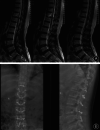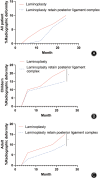Role of Posterior Longitudinal Ligament Complex in Spinal Deformity Secondary to Surgical Resection of the Intradural Tumor
- PMID: 36720712
- PMCID: PMC9977598
- DOI: 10.1111/os.13636
Role of Posterior Longitudinal Ligament Complex in Spinal Deformity Secondary to Surgical Resection of the Intradural Tumor
Abstract
Objective: In most cases, complete resection of the intradural tumor is accompanied by long-term neurological complications. Postoperative spinal deformity is the most common complication after surgical resection of intradural tumors, and posterior longitudinal ligament complex (PLC) plays an important role in postoperative spinal deformity. In this study, we investigated the role of PLC in spinal deformity after the surgical treatment of intradural tumors.
Methods: We analyzed the data of 218 consecutive patients who underwent intradural tumor resection from 2000 to 2018 in this retrospective study. Before 2010, patients underwent laminoplasty without maintaining the integrity of PLC (laminoplasty group, n = 155). After 2010, patients performed single-port laminoplasty to maintain the integrity of PLC (laminoplasty retain posterior ligament complex group, n = 63). The score of quality of life, painful cortex, spinal cord movement, progressive kyphosis or scoliosis, perioperative morbidity, and neurological results were analyzed in the laminoplasty group and laminoplasty retain posterior ligament complex group. The distributed variable was shown as mean ± standard deviation and an independent t-test or one-way analysis of variance was calculated.
Results: There are 155 patients (71.1%) included in the laminoplasty group, and 63 patients (28.9%) in the laminoplasty retain posterior ligament complex group. The average age of patients was 42 ± 2.3 years, and the average modified McCormick score was 2. There were 158 (72.4%) patients with intramedullary tumors and 115 (52.7%) patients with extramedullary tumors. The length of hospital stays (8 days vs. 6 days; p = 0.023) and discharge to inpatient rehabilitation (48.4% vs. 26.9%; p = 0.012) were significantly lower in the laminoplasty retain posterior ligament complex group than the laminoplasty group. There was no significant difference in the risk of progressive deformity between the two groups at 18 months after surgery (relative risk 0.12; 95% confidence interval [CI] 0.43-1.25; p = 0.258) and at 20 months after surgery (relative risk 0.24; 95% CI 0.21-2.1).
Conclusion: Laminoplasty retains posterior ligament complex showed no impact on the spinal deformities compared with laminoplasty, but significantly improved the postoperative spinal activity, alleviated pain symptoms, and reduced hospital recovery time.
Keywords: Intradural Spinal Tumor; Laminoplasty; Pain; Posterior Ligaments Complex; Spinal Deformity.
© 2023 The Authors. Orthopaedic Surgery published by Tianjin Hospital and John Wiley & Sons Australia, Ltd.
Conflict of interest statement
The authors declare no conflict of interest. The funders had no role in the design of the study; in the collection, analyses, or interpretation of data; in the writing of the manuscript, or in the decision to publish the results.
Figures



Similar articles
-
The impact of dynamic factors on surgical outcomes after double-door laminoplasty for ossification of the posterior longitudinal ligament of the cervical spine.J Neurosurg Spine. 2014 Dec;21(6):938-43. doi: 10.3171/2014.8.SPINE131197. Epub 2014 Oct 3. J Neurosurg Spine. 2014. PMID: 25279653
-
Short-term progressive spinal deformity following laminoplasty versus laminectomy for resection of intradural spinal tumors: analysis of 238 patients.Neurosurgery. 2010 May;66(5):1005-12. doi: 10.1227/01.NEU.0000367721.73220.C9. Neurosurgery. 2010. PMID: 20404708
-
[Discussion of surgical indications for posterior expansive open-door laminoplasty extended to C1 level].Zhongguo Xiu Fu Chong Jian Wai Ke Za Zhi. 2013 Oct;27(10):1214-20. Zhongguo Xiu Fu Chong Jian Wai Ke Za Zhi. 2013. PMID: 24397134 Chinese.
-
Cervical laminoplasty: a critical review.J Neurosurg. 2003 Apr;98(3 Suppl):230-8. doi: 10.3171/spi.2003.98.3.0230. J Neurosurg. 2003. PMID: 12691377 Review.
-
[The dorsal approach in degeneratively changed cervical spine].Orthopade. 1996 Nov;25(6):533-41. doi: 10.1007/s001320050057. Orthopade. 1996. PMID: 8999408 Review. German.
Cited by
-
Ipsilateral Fixation and Reconstruction of the Cervical Spine after Resection of a Dumbbell Tumor Via a Unilateral Posterior Approach: A Case Report and Biomechanical Study.Orthop Surg. 2023 Sep;15(9):2435-2444. doi: 10.1111/os.13798. Epub 2023 Jul 11. Orthop Surg. 2023. PMID: 37431728 Free PMC article.
References
MeSH terms
LinkOut - more resources
Full Text Sources
Medical

